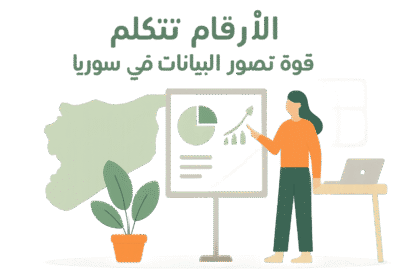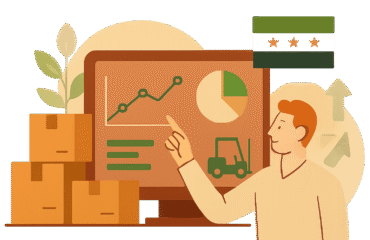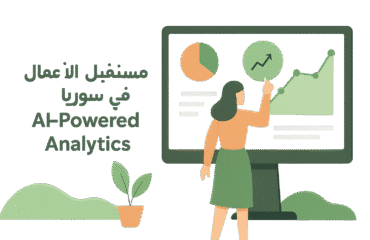
Turning Numbers into Stories: The Art of Data Visualization in the Syrian Context
- Transforming numbers into stories enhances decision-making efficiency.
- Data visualization aids in understanding complex information.
- Insight Syria leverages Artificial Intelligence to improve data insights.
- Data visualization gains particular importance in the Syrian context.
- We effectively address sensitive data quality challenges.
Table of Contents
- Why is Data Visualization Critical in the Syrian Context?
- The Art of Visualization: Beyond Abstract Numbers
- Insight Syria and its Data Visualization Expertise
- Practical Examples of Data Visualization in Syria
- Using Artificial Intelligence in Data Visualization
- Challenges and How We Overcome Them
- Conclusion
Why is Data Visualization Critical in the Syrian Context?
The Syrian context is characterized by its multifaceted complexities and challenges. From rebuilding infrastructure to understanding societal dynamics, from assessing humanitarian needs to monitoring market trends, vast amounts of data are generated. This data, if left as mere numbers and tables, loses its true value. This is where data visualization comes in:
- Simplifying Complex Information: Data related to population, economy, social services, or even political transitions is often highly complex and involves numerous variables. Charts, infographics, and interactive maps can transform this data into clear and easily understandable visuals. For instance, a map illustrating the distribution of humanitarian needs across Syrian governorates can quickly show the most affected areas, guiding relief efforts more effectively.
- Facilitating Pattern and Trend Discovery: Abstract numbers often hide significant patterns and trends. Data visualization can reveal these patterns, such as seasonal changes in commodity prices, the relationship between education level and employment opportunities, or the impact of a specific development initiative on people’s lives. Understanding these patterns helps in forecasting the future and making proactive decisions.
- Supporting Strategic Decision-Making: Data visualization allows decision-makers to see the big picture and better evaluate available options. Whether it’s allocating resources for development projects, assessing the effectiveness of awareness campaigns, or understanding public opinion on certain issues, the insights derived from visual data are more persuasive and quicker to grasp, leading to more informed and accurate decisions.
- Enhancing Communication and Transparency: In an environment that demands mutual trust, presenting data transparently and understandably is crucial. Data visualizations can facilitate organizations in showcasing their achievements, justifying their decisions, and communicating with the public or donors clearly and effectively. This builds trust and promotes transparency in operations.
- Understanding Societal and Political Dynamics: In a country like Syria, understanding public sentiment, population distribution, and the impact of policies on different societal segments is vital. Data visualization can play a significant role in public opinion analysis, consumer behavior studies, and monitoring social changes, providing a strong foundation for political and social initiatives.
The Art of Visualization: Beyond Abstract Numbers
Data visualization is not just about drawing charts. It is an art and science that combines statistics, graphic design, psychology, and an understanding of the data’s context. It requires more than just inputting numbers into a program; it demands a deep understanding of the story the data is trying to tell and the audience to whom this story is directed.
At “Insight Syria,” we follow a multi-faceted approach to data visualization, based on:
- Understanding the Target Audience: Are we speaking to technical experts, political decision-makers, or the general public? The type of chart, level of detail, and language used depend on the audience. For example, communicating with a government entity might require visualizations showing the economic and social impact of initiatives, while a humanitarian organization might need visualizations that clearly show the distribution of aid and field needs.
- Choosing the Right Tool: There are many tools and types of data visualization: bar charts, line graphs, pie charts, heatmaps, scatter plots, interactive dashboards, and geographic maps. Choosing the appropriate tool depends on the nature of the data and the message to be conveyed. For example, line graphs are excellent for showing trends over time, while maps are useful for showing geographic distribution.
- Focusing on Clarity and Simplicity: The goal is to make data easy to understand. This means avoiding visual clutter, using colors wisely, providing clear chart titles, and labeling axes correctly. In the Syrian context, where data can be sensitive or complex, this simplicity becomes even more important to ensure no misinterpretations occur.
- Storytelling: Good visual data does not just display numbers; it tells a story. The visual guide should lead the reader through the data, highlight key points, and ultimately lead to a deeper understanding. This requires skill in statistical data analysis, interpretation of results, and providing constructive recommendations.
- Interactivity and Updates: In the digital age, interactive dashboards are a very powerful tool. They allow users to explore data themselves, filter it, and delve into specific details. This type of visualization is very useful in market data analysis, data mining, and exploratory data analysis where users can ask different questions and get quick answers.
Insight Syria and its Data Visualization Expertise
At “Insight Syria,” we have a team of data analysis and AI experts who combine technical skills with a deep understanding of the Syrian context. We don’t just offer quantitative analysis and qualitative analysis services; we focus on delivering actionable insights through effective data visualizations.
Our services in this area include:
- Custom Dashboard Design: We develop interactive dashboards that display Key Performance Indicators (KPIs) in real-time, allowing decision-makers to monitor the situation and take necessary actions quickly. These dashboards can cover areas such as project monitoring, social impact assessment, and social media trend analysis.
- Geospatial Visualization: Using the latest technologies, we create interactive maps that illustrate the geographic distribution of data, which is vital in Syria for understanding population-related issues, resource distribution, or damage assessment. This falls under spatial data analysis and has wide applications in urban planning and disaster management.
- Creating Visual Charts and Reports: We provide comprehensive reports that include clear and compelling charts, tailored to meet our clients’ needs, whether they are seeking economic analysis, political analysis, or market studies. We ensure these visualizations are easy to understand and meaningful.
- Big Data Analysis and Visualization: With the increasing volume of data, we help organizations process and visualize large datasets, extracting value from them using deep data analysis and data mining techniques.
- Public Opinion and Survey Data Visualization: In the field of opinion polling and public opinion measurement, we use data visualization to present survey results visually, making it easier for clients to understand public sentiment and political and social trends. This supports political climate analysis and voter behavior understanding.
Practical Examples of Data Visualization in Syria
To illustrate the power of data visualization, let’s imagine some real-world scenarios in the Syrian context:
- Humanitarian Organization: An organization wishes to distribute food aid. Instead of providing a long list of towns, areas, and the number of people in need, we can create an interactive map showing the density of food needs in each area, with the ability to filter by age group or health status. This map would allow the organization to prioritize and allocate resources efficiently, with the potential to see constantly updated data from field data collection.
- Government Institution: The Ministry of Economy seeks to understand the impact of support strategies for small and medium-sized enterprises. We can create a dashboard displaying the growth of these enterprises by geographic sector and economic sector, comparing growth rates before and after the implementation of strategies. This would help in economic policy evaluation and identifying sectors that need more support, contributing to economic development and job creation.
- Research Institution: Wishes to study the impact of education on employment rates in different governorates. We can provide visualizations showing the relationship between different education levels and employment rates, highlighting disparities between governorates. This offers valuable insights for labor market analysis and human resource planning.
- Health Awareness Campaign: To launch a health awareness campaign about a specific disease, data showing the geographic spread of the disease, the most affected age groups, and recovery rates can be visualized. This data can be presented in easy-to-understand charts, perhaps linked to data from health surveys or health trend analysis, helping to target campaign messages accurately.
Using Artificial Intelligence in Data Visualization
Artificial Intelligence (AI) is increasingly intersecting with data visualization to provide more advanced solutions. Machine learning techniques can help in:
- Automatic Pattern Detection: AI algorithms can identify patterns and anomalies in data that may not be apparent to the human eye, and then suggest appropriate visualizations to display them. This supports knowledge discovery in data and machine learning.
- Generating Smart Visualizations: AI-powered systems can automatically generate visualizations based on user questions, speeding up the analysis process.
- Trend Forecasting: By analyzing historical data and visualizing it, AI can assist in forecasting future trends, such as sales forecasting or service demand forecasting.
At “Insight Syria,” we leverage the latest tools and techniques in applied artificial intelligence to enhance our data analysis and visualization capabilities, ensuring our clients get the most out of their data.
Challenges and How We Overcome Them
Despite the importance of data visualization, there are challenges in the Syrian context that can be encountered:
- Data Quality and Availability: Sometimes, data may not be readily available or may be inaccurate. We overcome this through our rigorous data collection and data quality assurance methodologies, and possibly by using data imputation techniques when necessary.
- Contextual Sensitivity: Some data, especially that related to politics or security situations, requires careful handling and utmost sensitivity to ensure it is not misinterpreted or misused. Our team is trained on these considerations to ensure responsible data analysis.
- Digital Divide: Not all decision-makers or end-users may have the same level of technical knowledge. Therefore, we focus on providing simple, clear, and accessible visualizations, along with the necessary support and training.
Conclusion
At “Insight Syria,” we believe that the ability to transform numbers into clear and persuasive stories is the cornerstone of making informed and effective decisions. Through our expertise in data analysis and AI, and our focus on data visualization, we are committed to helping governmental institutions and organizations understand their reality, identify opportunities, and confront challenges in the complex Syrian context.
If you are looking for a partner who can assist you with data analysis, opinion polling, market research, and social and political analysis, while providing actionable insights through powerful data visualizations, then “Insight Syria” is your destination. Let us help you turn your data into stories that change reality.
Frequently Asked Questions
What is the importance of data visualization in decision-making?
Data visualization contributes to clarity of insights and understanding of trends, which helps in making informed and more accurate decisions.
How can Artificial Intelligence improve data visualization?
AI can automatically detect patterns and generate relevant visualizations, helping to speed up the analysis process.
What are the challenges facing data visualization in the Syrian context?
Challenges include data quality and availability, contextual sensitivity, and the digital divide among users.



